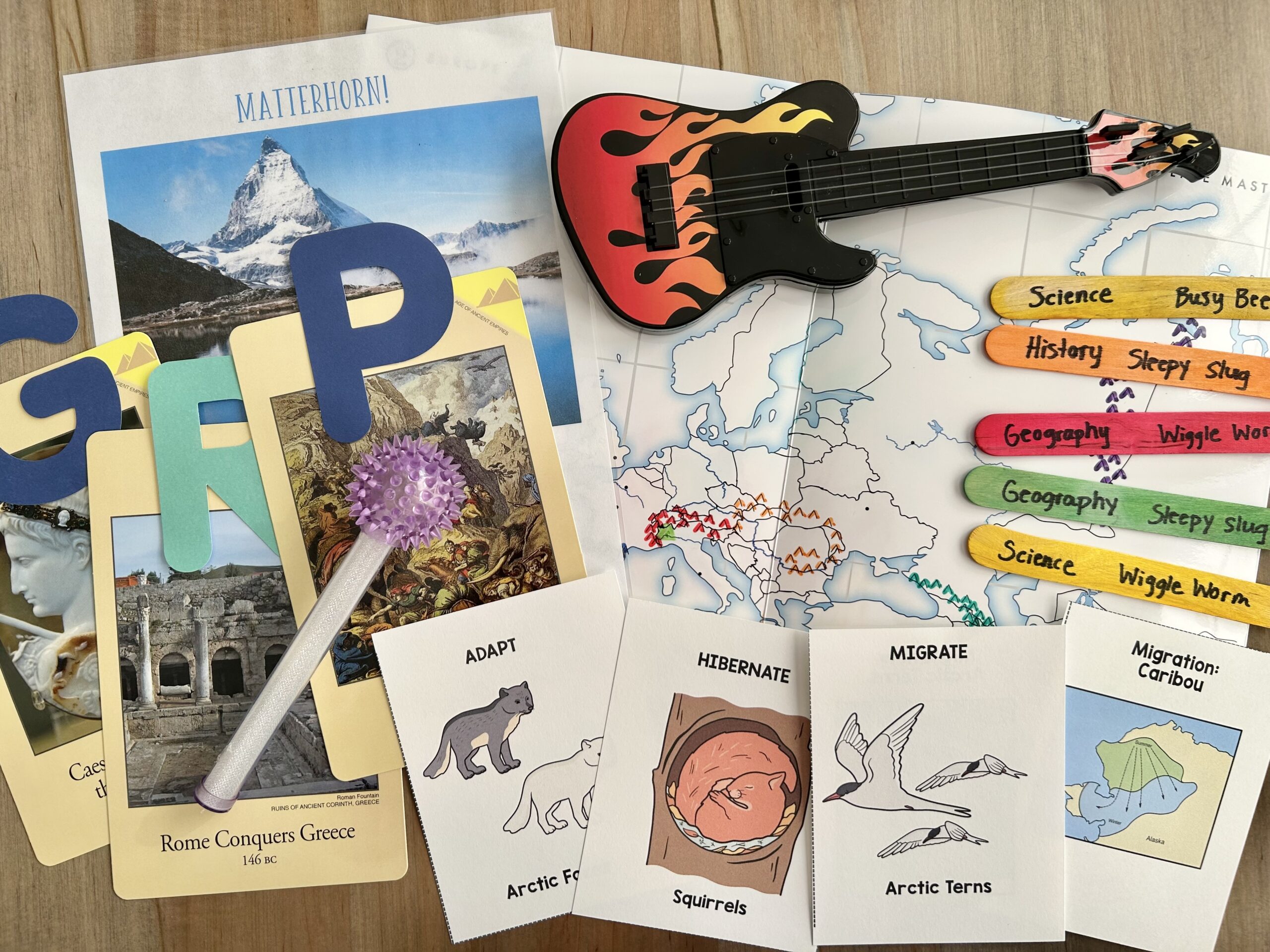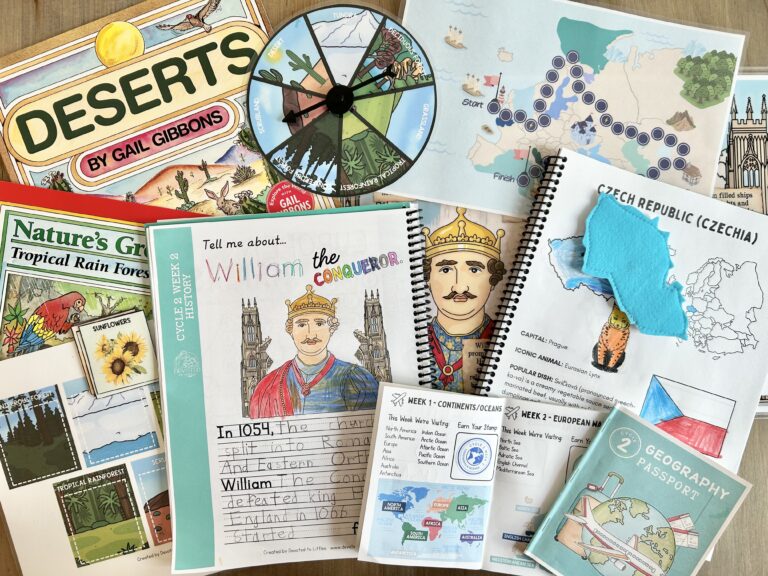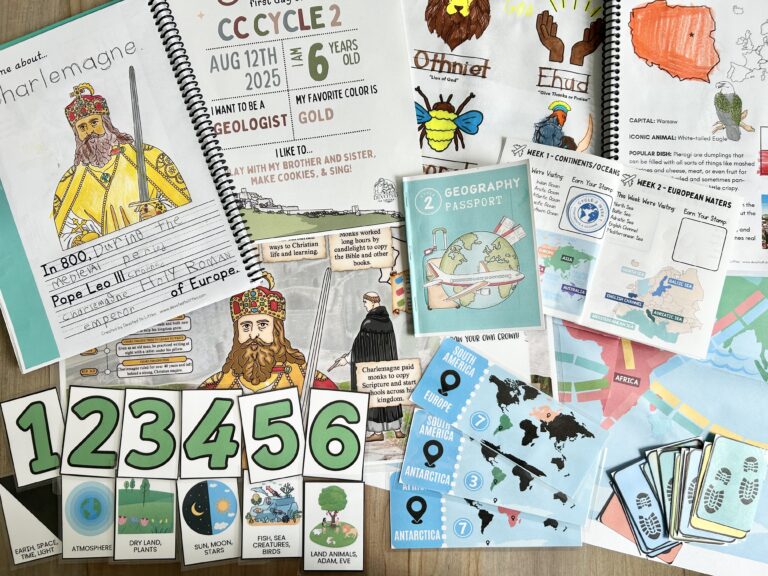Cycle 2 Week 6 Tutor Ideas for Classical Homeschooling
For this week, I’ve planned activities that keep things fresh and interactive while still being simple enough to manage with little learners. My goal is always to weave in movement, laughter, and repetition in ways that help the memory work really stick.
As always, I’m not affiliated with any Classical education organization—these are just my own ideas and practices from tutoring over the years. I hope these Week 6 plans give you fresh inspiration and encouragement as you prepare for your own class or homeschool day.
We love being part of our Classical homeschooling community. Read more about how God redirected our path from private education to homeschooling and Classical education here.
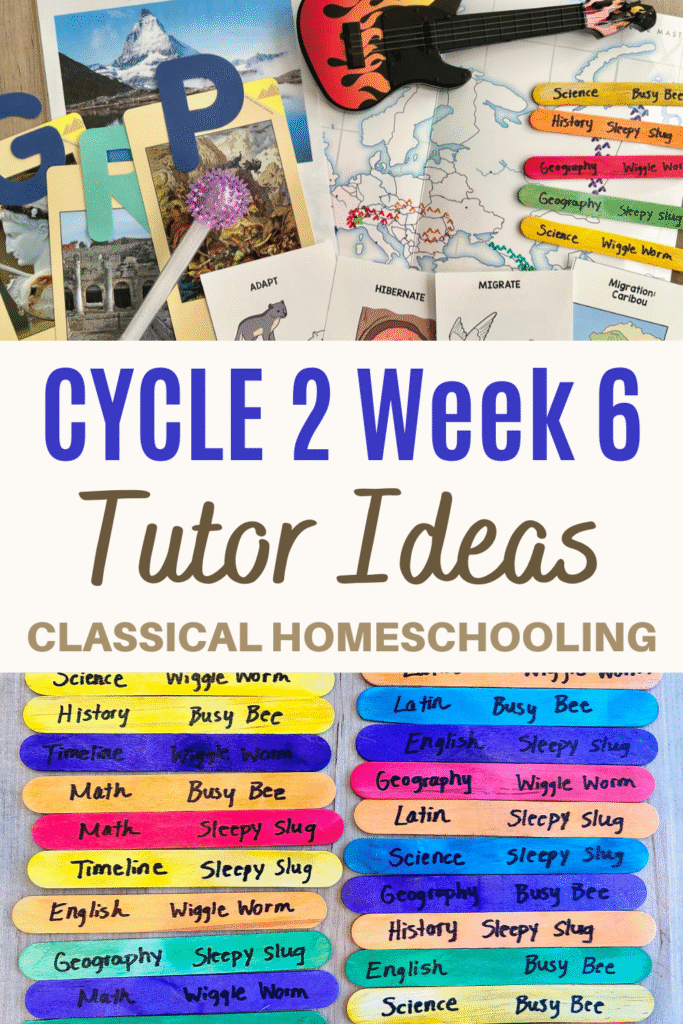
This post contains affiliate links, which means I make a small commission at no extra cost to you. See my full disclosure here.
Are you new to the Classical model and want to know more about it? Keep reading below about how it’s organized, the different cycles, our community time, and MORE!
If you already know about the Classical homeschooling model and you are ready to jump to the actual tutor ideas, click HERE.
A Classical model of homeschooling
We are part of a Christ-centered homeschool program that follows the Classical model. The younger children, ages 4-12, focus on a memorization-based curriculum which acts as the groundwork of learning that is built upon in later years.
Children and their parents learn key facts across the core subject areas including history, science, English, mathematics, geography, and Latin. Tutors use fun activities, games, songs, and lots of energy to introduce the new material. The parents can then expand on that material at home throughout the week.
Cycle rotation
The material is divided into three cycles, which each last one year. The cycles continue to rotate every three years, so most children who start when they are kindergarten age, complete each cycle at least twice. This allows them to develop a deeper comprehension and grasp of the material through repetition.
Cycle 2 material
This year in Cycle 2, we’re learning about pre-Reformation to modern history, ecology, astronomy, and physics; Latin verb endings; English pronouns, adverbs, and conjunctions; skip counting, conversions, and more!
The following ideas are what I’m planning to do with the group of kids I am tutoring this year (ages 4-6). You may use these ideas if you are also tutoring in a Classical homeschooling community, or if you’re a parent who is looking for memory work ideas to use at home.
Also, you don’t have to be part of any particular Classical homeschooling group to use these ideas! These are ideas to help children learn key concepts in the core subject areas. If you are a homeschooling parent, or just a parent who wants to supplement what your kids are currently learning in school, these ideas will be helpful for you.
Community group time
Our homeschooling community has been meeting on Tuesdays. Our leader starts off the morning with everyone together in a big group setting. She typically begins that time with a devotional reading and prayer, and then continues with some announcements, celebrating birthdays, the pledge of allegiance, and anything else she wants to cover with everyone.
After this time, we split off into our different groups based on age. The tutors lead their groups into different classrooms and begin the New Grammar part of the day. This is when the tutor introduces the memory work for each core subject. Check out my post and video about how to make your own tutor board!
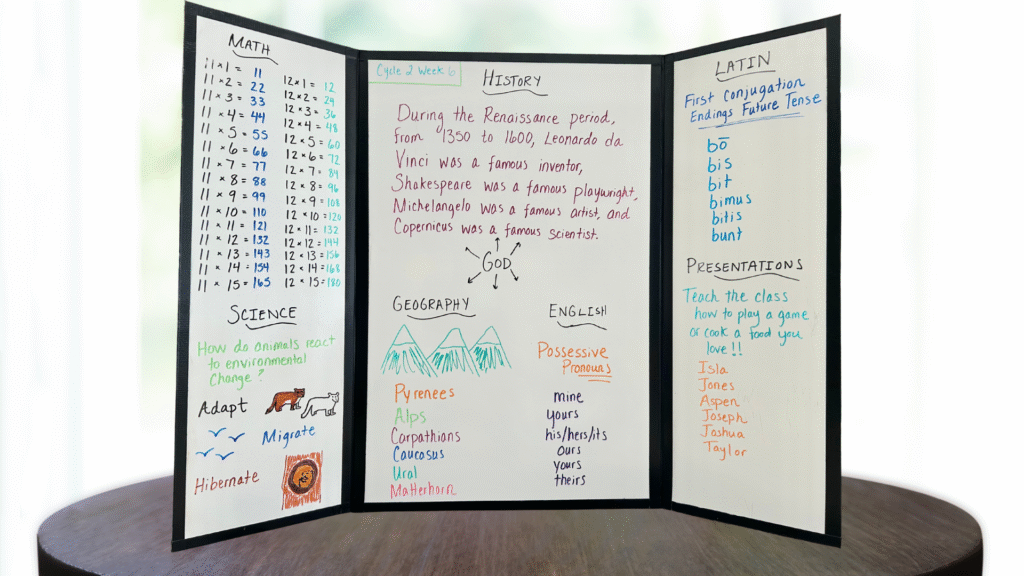
Cycle 2 Week 6 Tutor and Memory Work Ideas
New Grammar
Geography – European Mountains
This week in geography we are learning about the European Mountains: Pyrenees, Alps, Carpathians, Caucasus, Ural, and the Matterhorn.
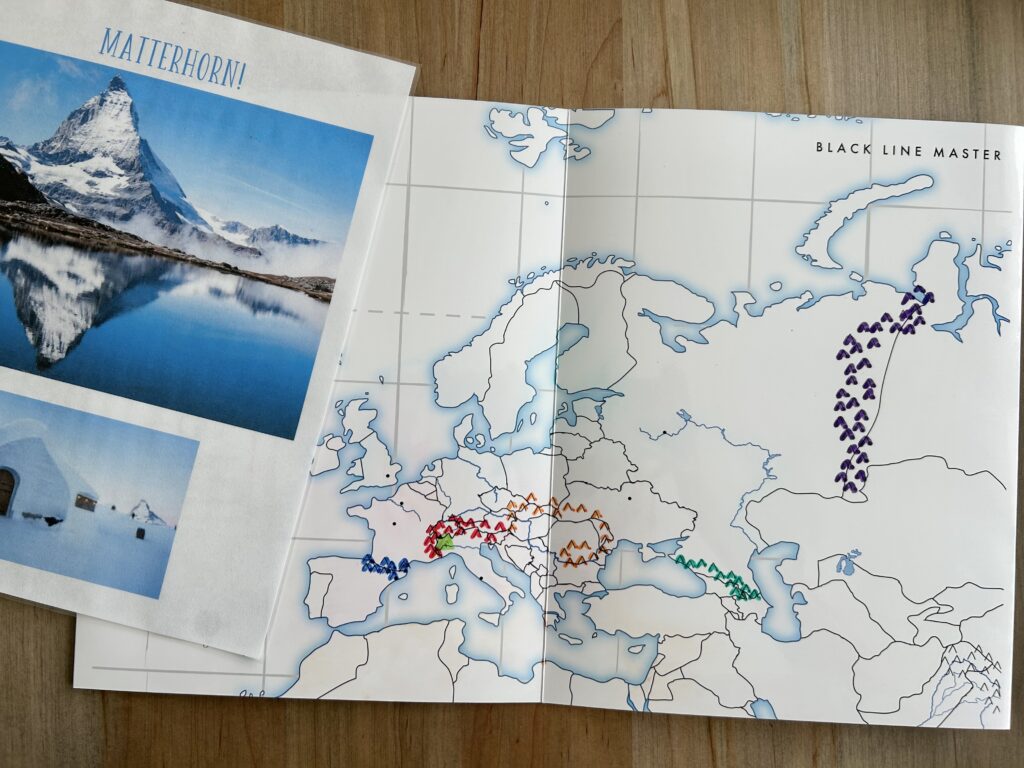
Before introducing the new material, we’ll take a few minutes to review the cities we learned last week. Then we’ll set off on a new adventure—this time traveling to some mountains! I’ll have the mountain ranges outlined on these trivium table maps in different color dry erase markers so they stand out clearly.
To make the lesson memorable, we’ll go on a pretend hike through Europe. I’ll point out each mountain range on the map and tell the kids a little story to help them remember:
- In the Pyrenees, we hear buzzing bees.
- In the Carpathians, we meet a boy riding a horse named Nathan.
- In the Alps, we put a helmet on our scalp to climb high mountains.
- In the Caucasus, we need a bus to get there because it’s so far away.
- In the Ural Mountains, we dance and twirl in the windy breeze.
- Finally, at the Matterhorn, we arrive in the early morn of the next day.
As I tell the story, the children will follow along with me on their maps, “hiking” from mountain to mountain. I’ll also show the kids a picture of the Matterhorn and explain that nearby, in the village of Zermatt, people can even stay in an igloo hotel!
Then, I’ll teach them a fun review song to the tune of She’ll Be Comin’ Around the Mountain, using all six mountain names. We’ll sing it several times while pointing to each mountain on the map. See my video below.
To finish, I’ll quiz them with questions like:
- “Who remembers which mountain range had the buzzing bees?”
- “Where did we twirl in the windy breeze?”
- “What mountain did we climb in the early morn?”
This combination of story, song, and questions gives the kids lots of repetition and makes learning the mountains both active and fun.
English – Possessive Pronouns
This week we are continuing with pronouns, moving into possessive pronouns. We’ll keep using the same song to the tune of Here We Go Looby Loo, so the children can keep stringing all the pronouns together from Week 4 through Week 13 in one fun, continuous song.
To start, I’ll introduce just the possessive pronouns for this week: mine, yours, his, hers, its, ours, yours, theirs. I’ll sing them with the tune, and then invite the kids to join me. We’ll use the same simple motions as before, gently swinging our arms side to side in rhythm with the song. The movement gives their bodies something to do while their minds focus on the words, which makes memorization so much easier.
Once we’ve practiced the new set, we’ll sing from the very beginning, adding the nominative and objective pronouns we learned in the past two weeks. By the end, the kids will be singing all three groups together, building a strong foundation for the weeks ahead!
Here’s the video if you’d like to use the same song and motions:
After practicing together, we’ll sing it a few more times in different ways: quiet voices, loud voices, whisper, etc.
Timeline
The timeline stays the same each cycle, and this week we continue with the next seven cards.
I often use these Timeline Cards in class: Set 1 (Ancient World), Set 2 (Medieval World), Set 3 (New World), and Set 4 (Modern World) I highly recommend investing in them (you should get all four sets) whether you are a tutor or a parent. I consistently use them as a tutor and also at home with my kids.

Since I have the 4-6 year old children, I like to tape the paper letter that the timeline event starts with at the top of the card. I have found these letters at my local Dollar Tree. Some of the children in my class can’t read yet, so this helps them identify the event I’m referring to.
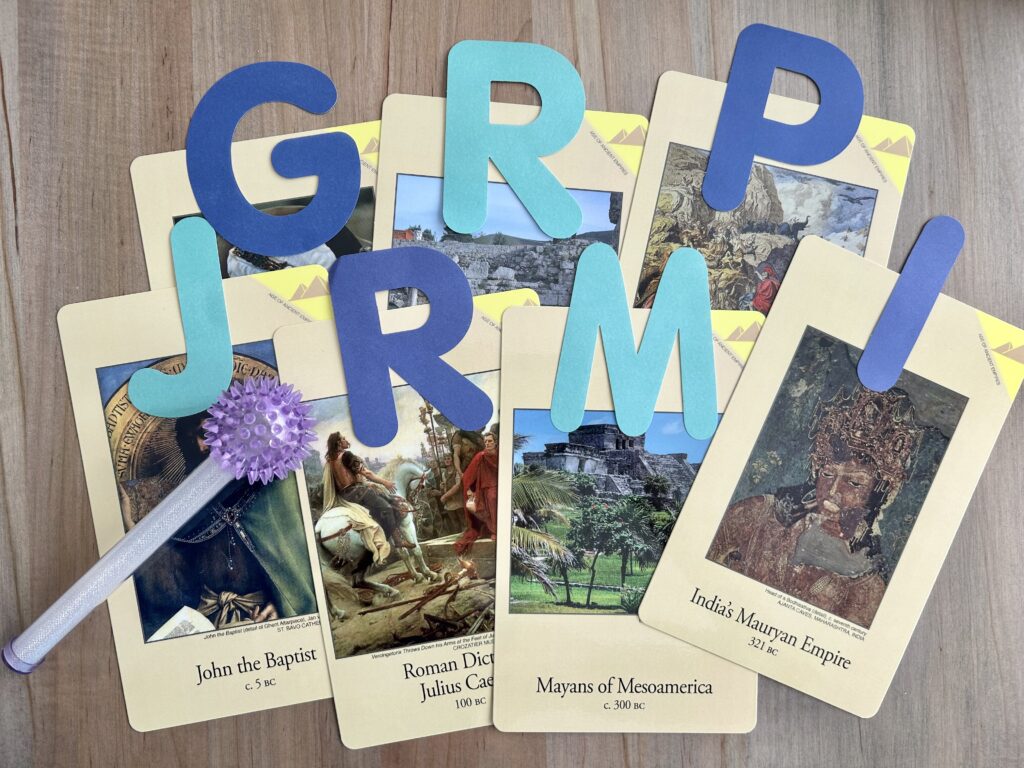
Cycle 2 Week 6 Timeline
Before our class time begins, I put seven pieces of painters tape on the wall where the timeline cards will go, then I hide the cards around the room. I try to choose hiding spots that aren’t too tricky but still make the game fun.
When it’s time to start Timeline, I tell the children to find one or two cards (depending on how many kids I have) and bring them back to their seats. As they search, I sing this week’s part of the timeline song (instead of playing it), so I can set the pace and keep them focused. See my tutor video for the tune of this week’s timeline song.
Once all the cards are found, we work together to put them in the correct order. For example, I’ll say, “The first card is
India’s Mauryan Empire. What letter does ‘India’s’ start with?” A child will answer, “I!” Then I ask, “Who has the card with a I on it?” That child brings the card to the front and sticks it on the first spot of painter’s tape. We repeat this until all of the cards are in the correct order.
Afterward, I give a light up stick to the first child. Each child takes a turn coming up to the wall and tapping the cards one by one with their light stick as we sing through the timeline song together. This helps them connect the words with the visual order of the cards, and the added movement keeps them engaged. We always finish by practicing the hand motions while singing.
See my video below which includes the hand motions for this week’s timeline section:
Math
This week in math we are skip counting the 11’s and the 12’s.
We’ll start with the 11’s. I’ll sing them to the tune of Row, Row, Row Your Boat while pointing to the numbers on my board. See my tutor video for this tune. Then I’ll invite the kids to join me as we “row our boats” together. To keep things engaging, we’ll change up the way we row each time:
- Slowly
- Fast
- Through rough waters
- Through gentle waters
For the 12’s, we’ll sing them to the tune of Here We Go Round the Mulberry Bush. See my tutor video for this tune. I’ll sing once while pointing to the 12’s, then the kids will join in. Each time we repeat the song, we’ll move around the table in different ways:
- Walking
- Skipping
- Lightly jogging
- Crawling
For added variety, you can also hand out movement cards (get these FREE below!) and let the kids take turns choosing an action for everyone to do while singing the 12’s.
This routine keeps the kids moving and laughing while giving them plenty of repetition with both sets of skip counting facts. You can also use these fun action cards that you can download for free below!
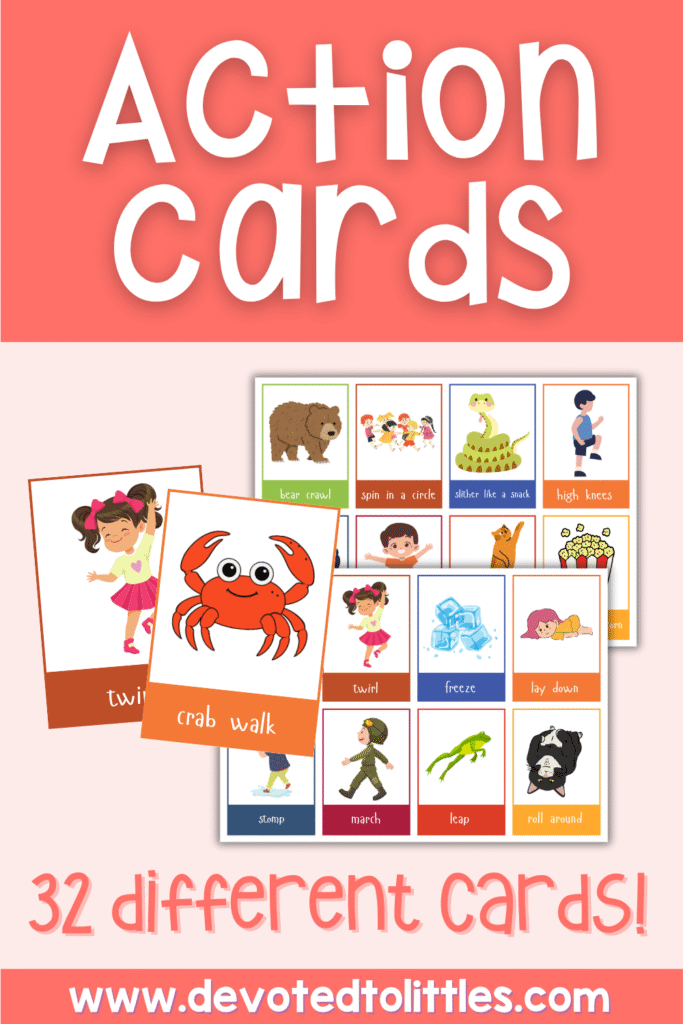
You can download my UPDATED printable Silly Voice and Action Cards for free by entering your email in the form below and I’ll send them straight to your mailbox!
Silly Voice and Action Cards
History
This week our history sentence is: During the Renaissance period, from 1350 to 1 600, Leonardo da Vinci was a famous inventor, Shakespeare was a famous playwright, Michelangelo was a famous artist, and Copernicus was a famous scientist.
To help the kids learn this sentence in a fun way, we’ll play the “Silly Words” game again.
First, I’ll sing the history sentence correctly and ask the children to listen carefully (see my tutor video for this week’s tune). Then, I’ll sing it again but sneak in silly words. For example:
During the Renaissance Cheerios, from 1350 to 1600, Leonardo da Pizza was a famous inventor, Shakespeare was a famous playtoy, Michelangelo was a famous gymnast, and Copernicus was a famous dentist.
Whenever they hear something silly, the kids raise their hand and tell me the correct word. Each time they correct me, I go back and repeat the sentence correctly from the beginning until I get to the next silly word. This way the children hear the correct sentence many times while laughing and staying engaged.


Then I hand out these cute miniature guitars to each of the children and encourage them to strum their guitars as we sing the history song a few more times.
Science
This week in science, we’re learning about how animals adapt to environmental changes—adapt, migrate, and hibernate.
To begin, I’ll teach the children a simple song to the tune of Peace Like a River. See my video below:
The melody is easy to follow, and the repetition helps the words stick. We’ll add fun motions to go along with each adaptation:
- Adapt → hide their face with their hands
- Migrate → spread arms out wide and pretend to fly
- Hibernate → curl up and pretend to sleep
We’ll sing the song a few times with the motions, starting slowly and then mixing it up with faster or quieter versions to keep it fun.
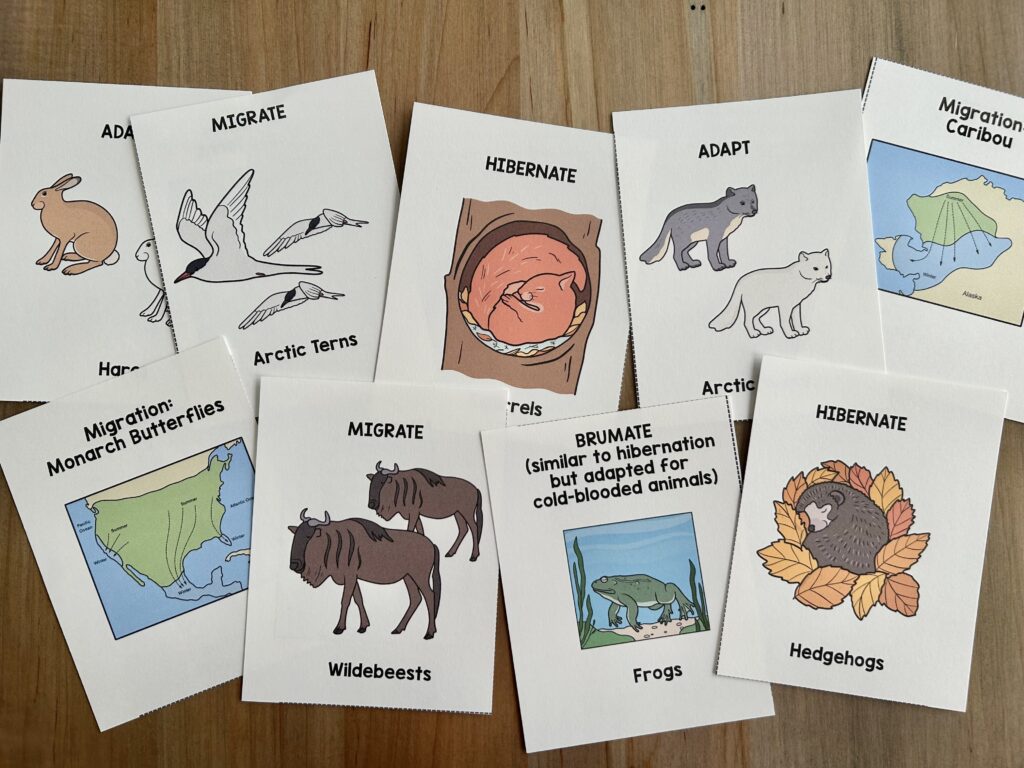
After that, I’ll bring out the adaptation cards I made. These cards each show an animal and how it adapts—either by adapting, migrating, or hibernating. The children will sit in a circle and take turns choosing a card. Together, we’ll look at the picture, name the animal, and decide how it is adapting.
On the back of the migration cards, I’ve included simple diagrams showing where the animals migrate. The kids love turning the card over to see where the animal goes, and it gives us a chance to connect the concept to geography as well.
This activity gives the children both a visual and kinesthetic way to understand the three different strategies animals use to survive environmental changes. It’s simple, interactive, and very memorable! Grab it for free here!
Latin
Our Latin memory work this week focuses again on the first conjugation verb endings in the future tense:
-bō, bis, bit, bimus, bitis, bunt. See my tutor video for the tune we sing these to!
This week in Latin we are playing a game called Sparkle to review the noun endings. The children sit in a circle, and I start by singing the first ending, “-bō.” The child to my right sings the next ending, and so on around the circle until we have sung through all of them.
The first time we play, we’ll only sing through the singular endings. The next round, we’ll sing through the plural endings. After that, we’ll alternate between singular and plural each time we start again. This gives the kids repeated practice without overwhelming them.
When a child sings the very last ending, the person to their right—who would normally go next—says “Sparkle!” That child is “out” and moves to sit just outside the circle. We then start again from the beginning and continue until only one child (or maybe the tutor!) is left. The kids love seeing who will last the longest, and it gives us lots of repetition in a fun and engaging way.
To keep things extra lively, I sometimes hand out silly voice cards (linked here). We switch off singing the noun endings in the different silly voices. This always gets lots of laughs and helps keep their attention, especially as the day goes on.
Review
For review time this week, we’ll play a game called “Wiggle Worm.” 🪱
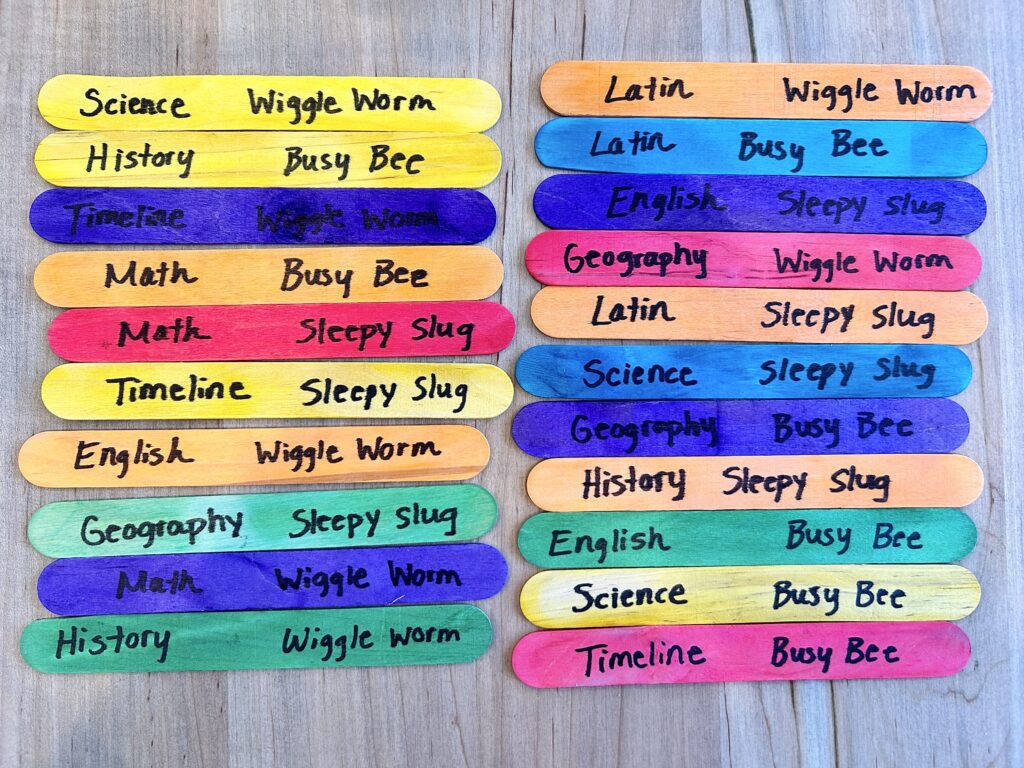
On Popsicle sticks, I’ve written all seven subjects of the memory work, along with a few special prompts: “wiggle worm,” “sleepy slug,” and “busy bee.” I’ll place all the sticks face down on the table, and the children will take turns picking one.
When a child chooses a stick, everyone will first act out the motion on the stick for a minute.
- Wiggle Worm → wiggle on the floor like silly worms
- Sleepy Slug → curl up and “sleep” while answering
- Busy Bee → flap their arms and buzz like bees
Then I’ll ask the group a review question from the subject written on it.
The kids love moving their bodies in silly ways! It keeps them laughing and engaged while still practicing the memory work.
I like to ask questions on the fly rather than prepping them ahead of time. Here are a few examples I might use (especially since my class is the youngest age group):
- Can you name one of the European cities we learned last week?
- What are the three types of consumers?
- What is one of the pronouns we’ve learned so far?
- Who remembers part of the timeline song so far?
We’ll keep going until each child has had a turn picking a Popsicle stick. It’s such a simple game but always a big hit with little learners!
Our NEW Cycle 2 Memory Work Activity Book
If you’re looking for a fun way to review the memory work at home with your kids this year, check out our NEW Cycle 2 Memory Work Activity Book. I created this notebook to give kids a fun way to practice their memory work, without adding extra prep for mom, dad, or grandma.
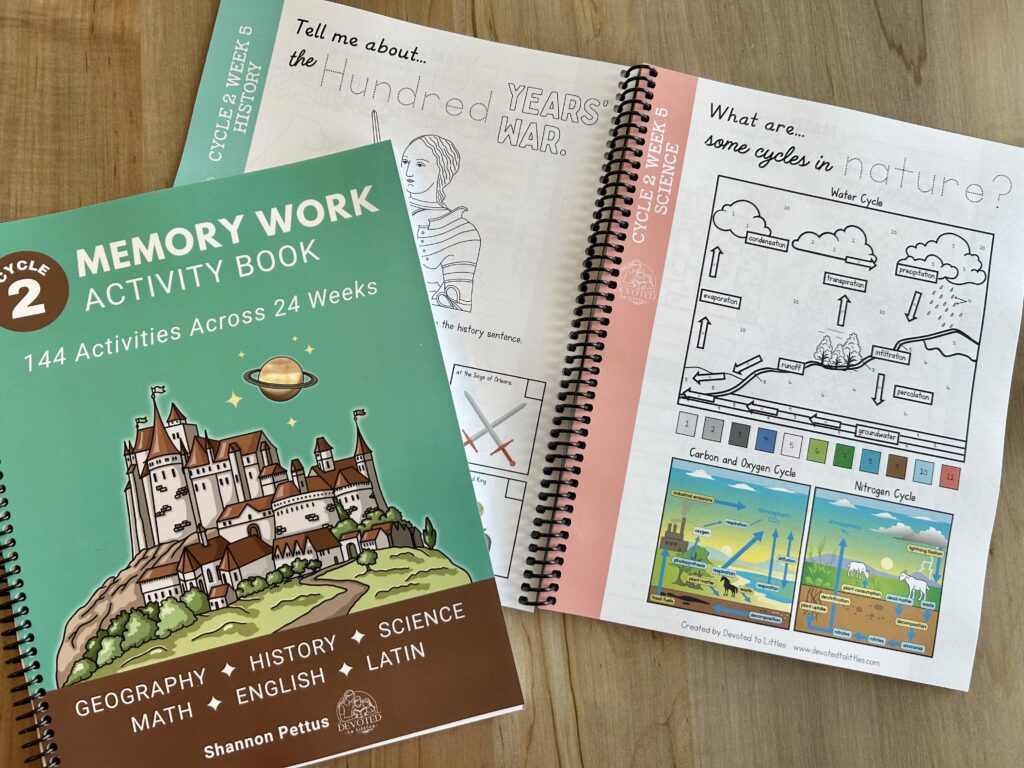
Inside, there’s one short activity for each subject for all 24 weeks of Cycle 2. When we do geography on Monday, they do the geography activity for that week. When we get to Thursday, they do the science page. It’s so easy to match to whatever we’re focusing on that day.
I love that it keeps things simple and fun. It’s NOW available in digital and printed form, and there is a sample page you can take a peek at if you would like too! Check it out below!
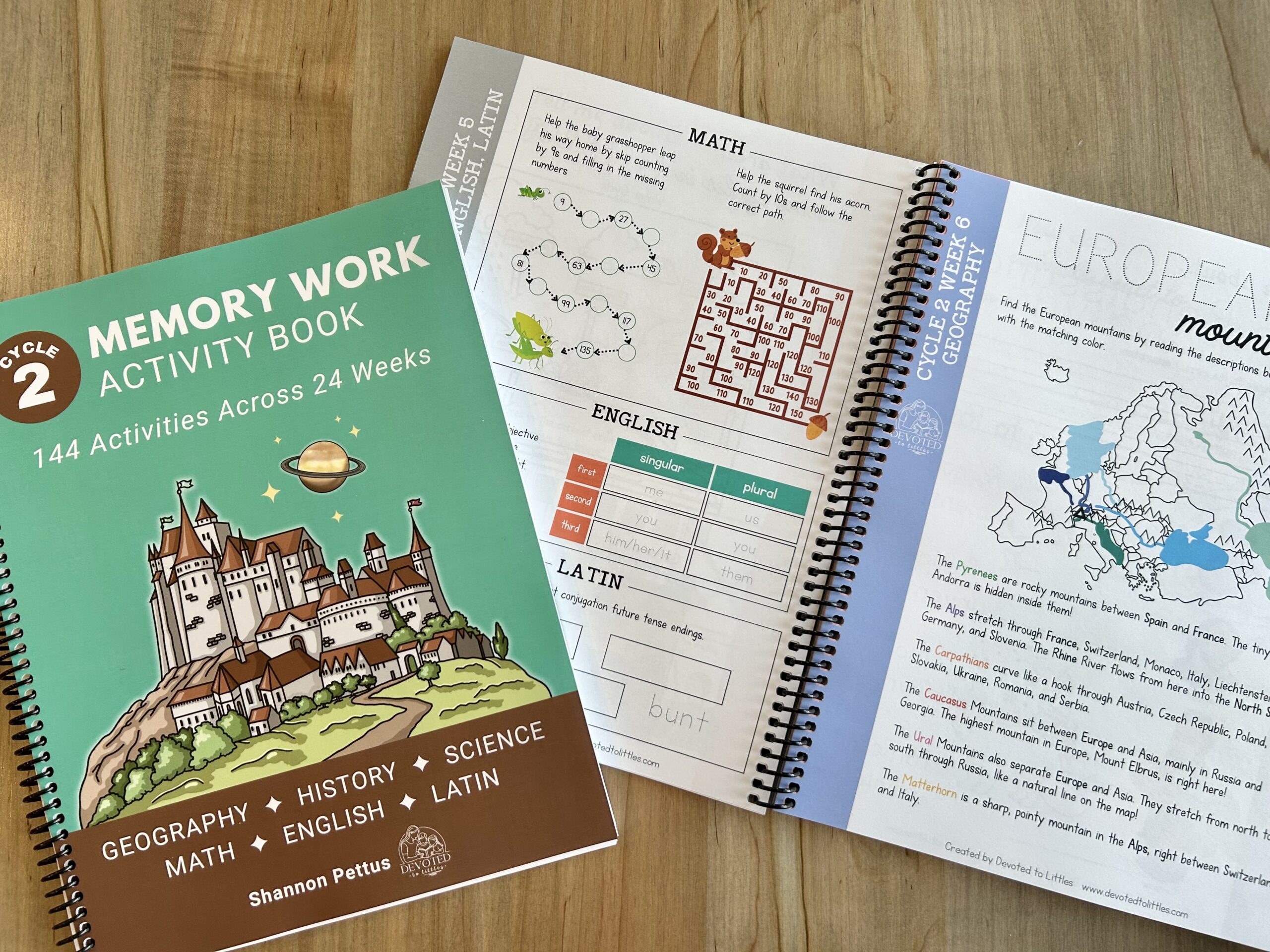
NEW Cycle 2 History and Science Placemats
These brand-new Cycle 2 History and Science Placemats are designed to make memory work fun and interactive for kids, whether you’re using them alongside Classical Conversations or on their own as a way to dive deeper into history and science.
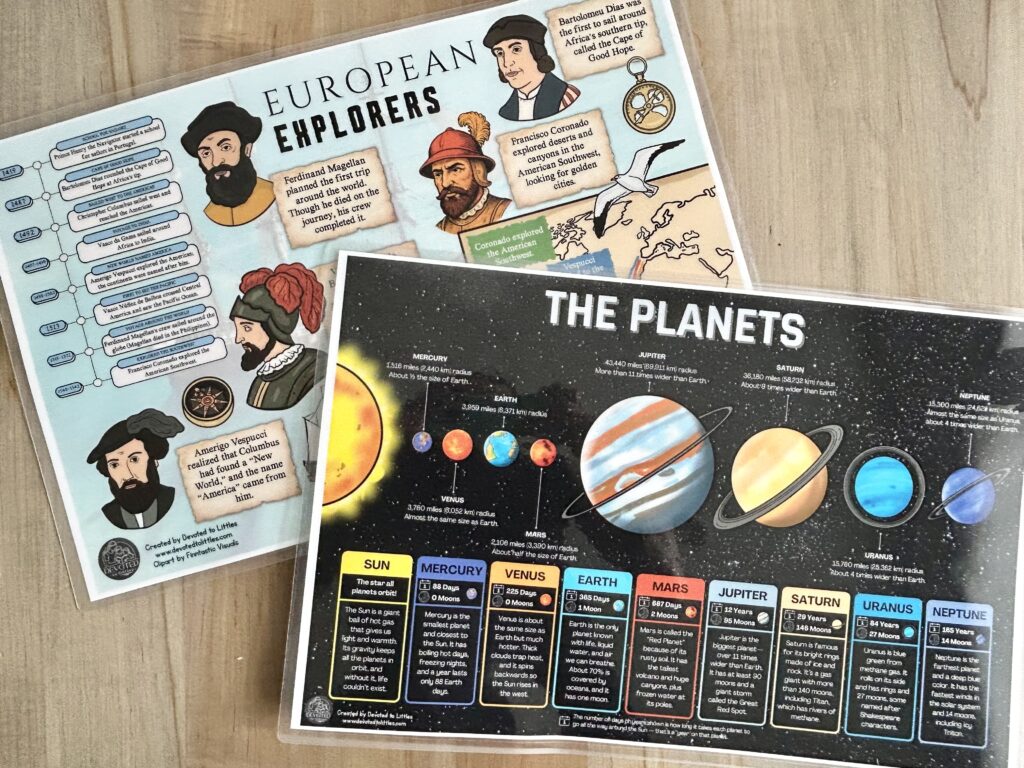
Each placemat is filled with colorful visuals and simple explanations that bring the topics to life. Just print, laminate, and use them again and again during meals and review time. They’re an easy, no-prep way to dive deeper into the history and science topics with your kids. Get your set for Weeks 7-12 below. Weeks 1-6 are also available HERE! Future weeks will be available soon!
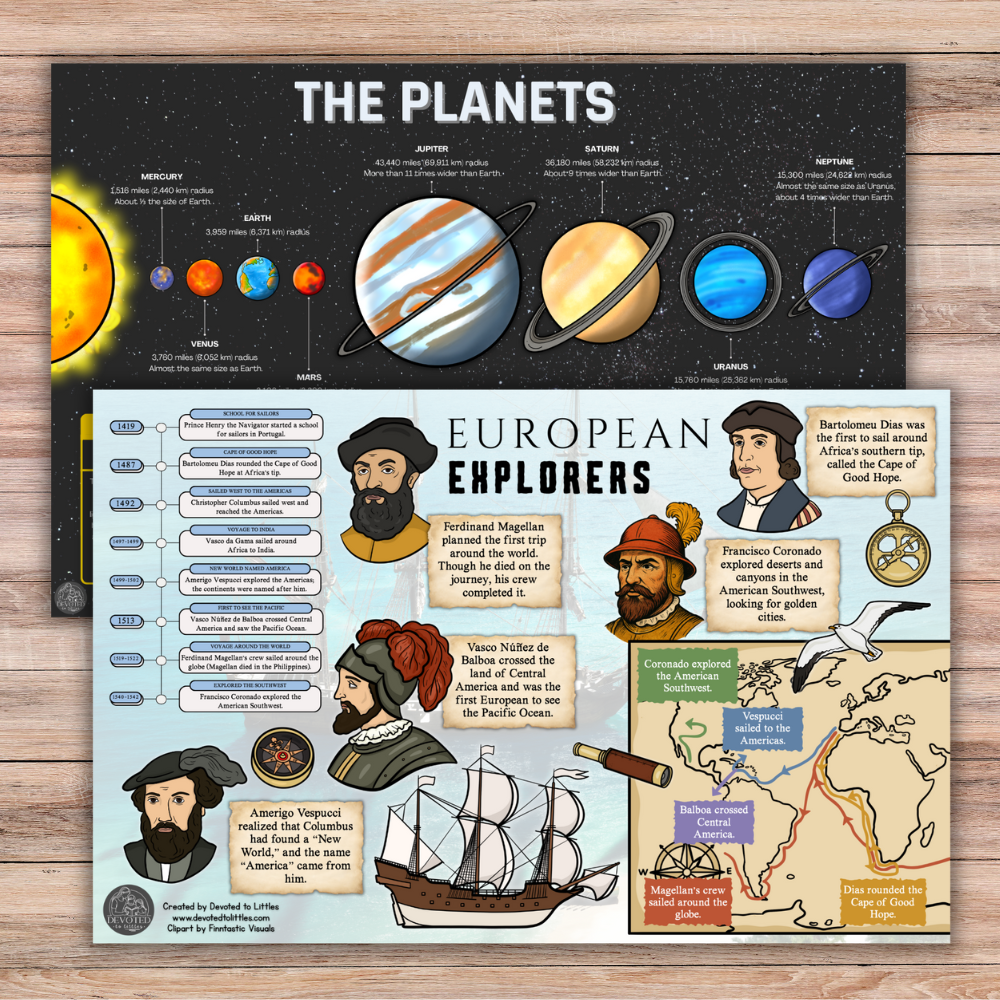
Cycle 2 Pronoun Memory Cards
These Pronoun Memory Cards cover all 75 pronouns from Cycle 2, Weeks 4–13 and can be used in three different games. Each card includes a sentence, a colorful image, and the pronoun type, making it easy for kids to connect meaning with usage.
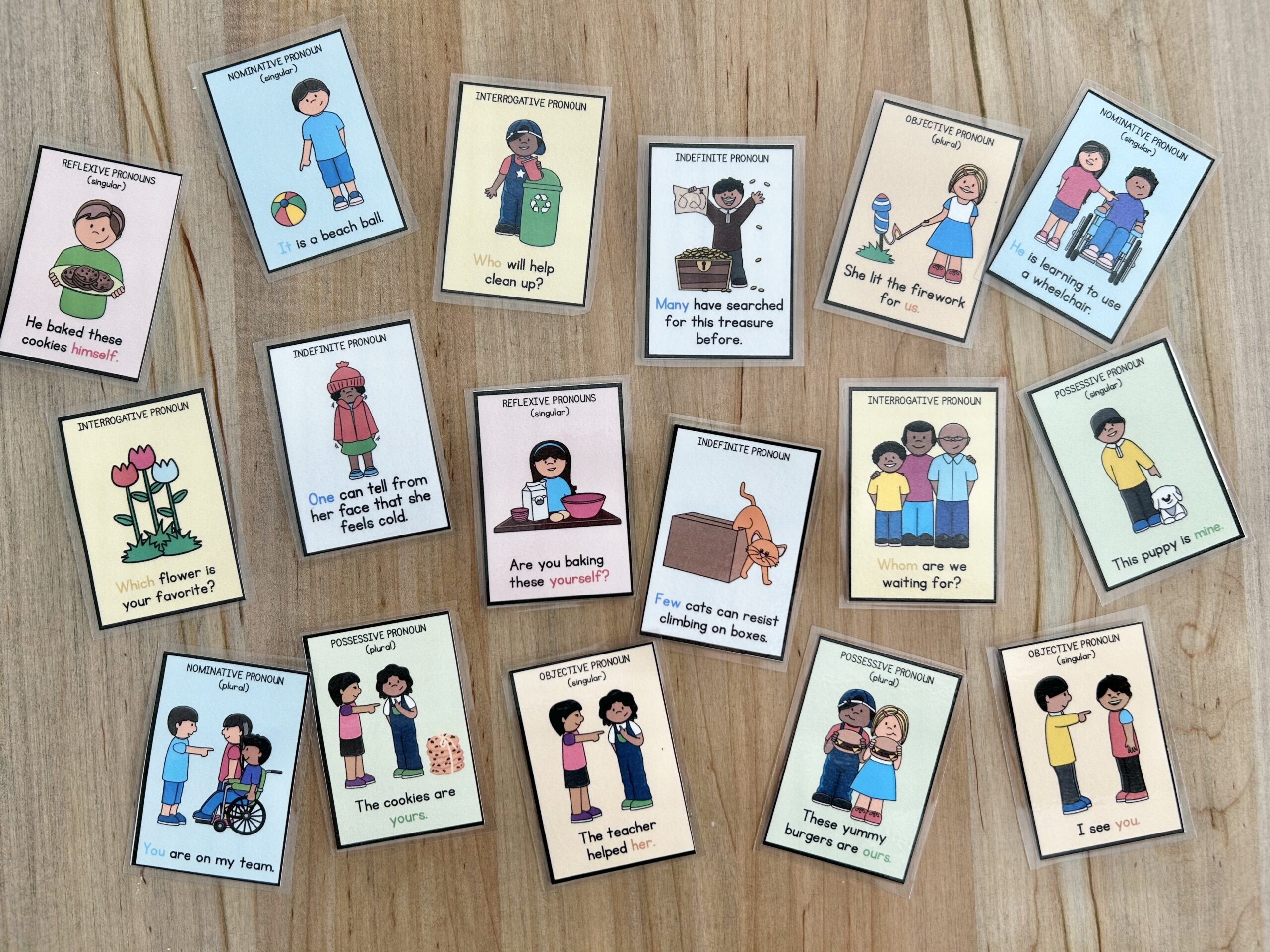
You can sort them by pronoun type, play a classic memory match, or try the fill-in-the-blank version for an extra challenge. My kids loved playing, and it gave them tons of practice without it feeling like drill. This set has quickly become one of our favorite go-to grammar review tools!
Cycle 2 Geography Passport
We also have a fun addition for geography review — the Cycle 2 Geography Passport! Whether you’re a tutor or a homeschool parent, this printable resource helps kids track their Classical Conversations Cycle 2 geography week by week with full-color maps and matching cut-and-glue stamps.

Each page highlights that week’s memory work with clearly labeled locations, making it easy for young learners to connect what they’re memorizing with what they see on the map. Kids love collecting stamps as they “travel” through the world. You can also print these stamps on these sticky circular labels which makes it even more fun!
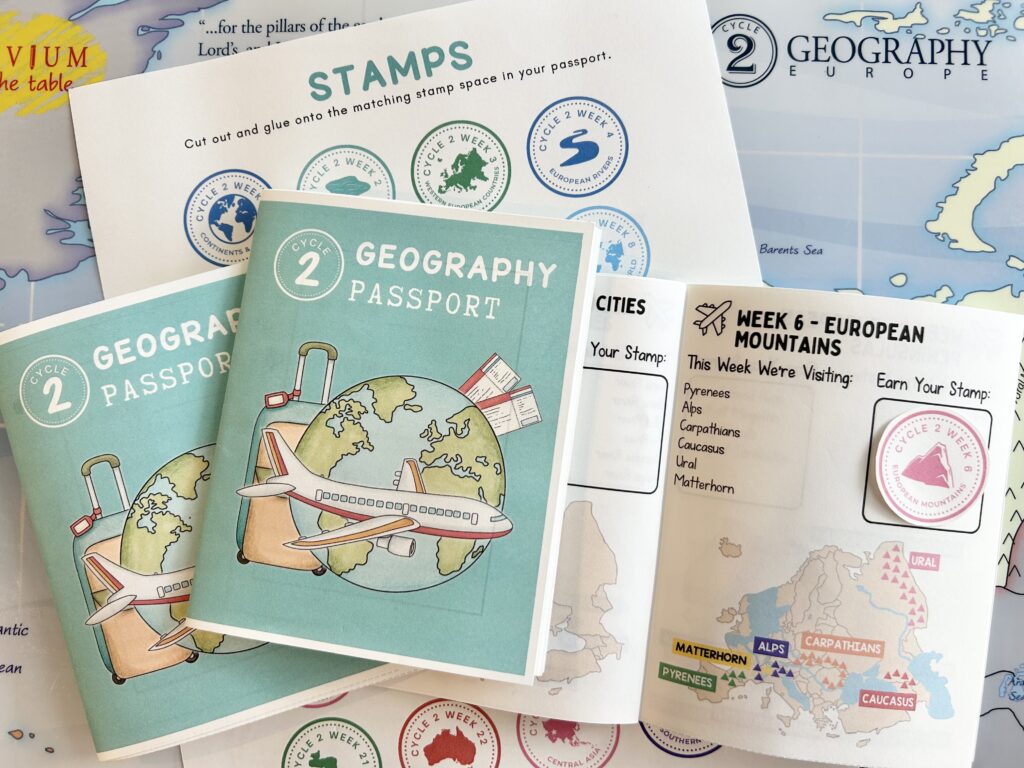
You can use the Geography Passport at home with your own children, or print it out for use in class. A group license option is available if you’d like to use it with your tutoring class or community group.
It pairs perfectly with the Cycle 2 Memory Work Activity Book, giving your students or children a hands-on, engaging way to practice their memory work all year long. If you’d like both resources, be sure to check out the bundle option available in my shop!
Printable and Editable Cycle 2 Week 6 Tutor Plans
Here is a printable EDITABLE template of these Cycle 2 Week 6 Tutor Plans. Here is a blank template too! If you want the plans as they are, here is a PDF version (filled out) and a PDF version (blank).
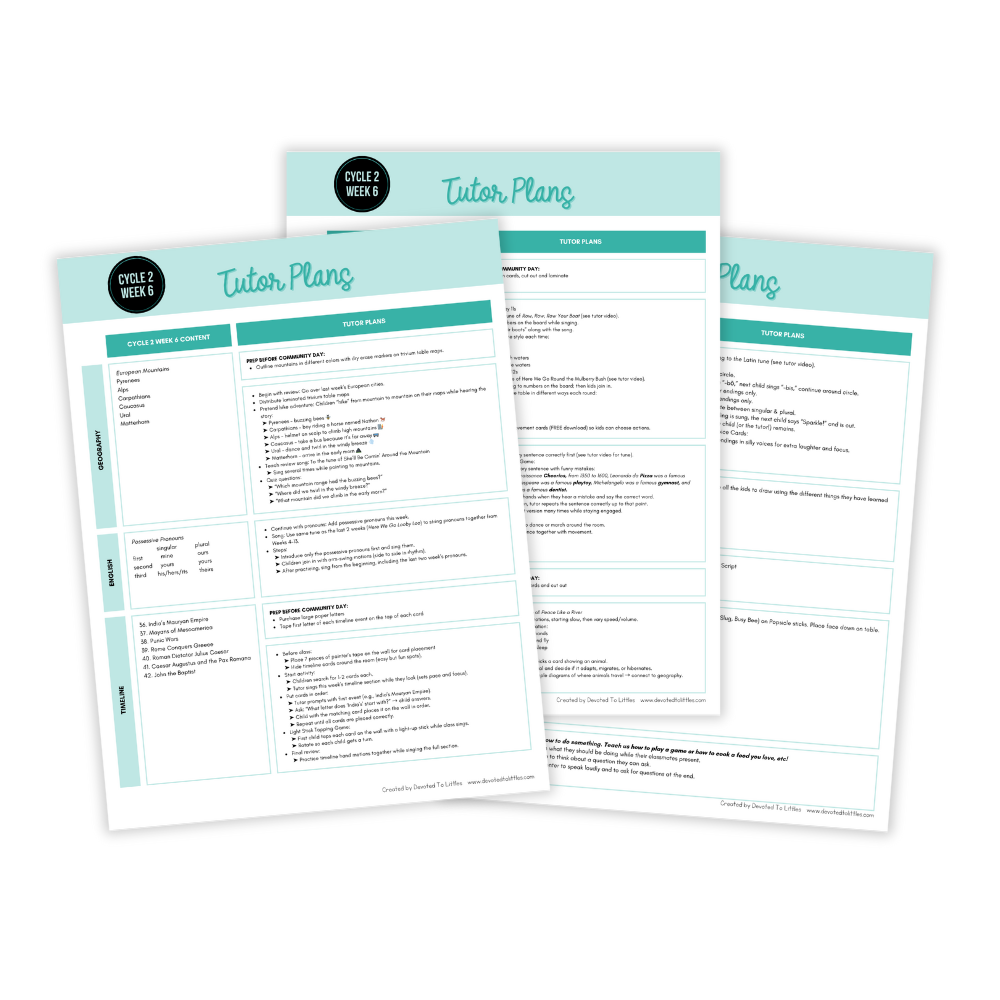
Cycle 2 Week 6 Memory Work Games
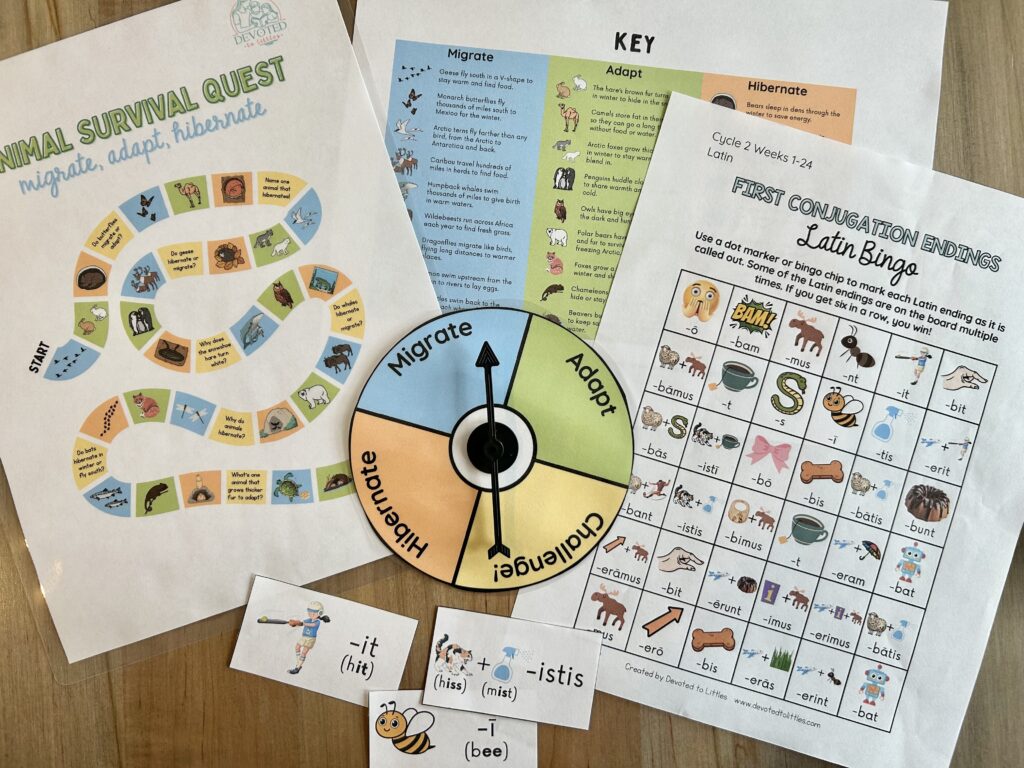
Also check out the FREE activities and games that you can use at home to help your kids practice the memory work this week.
I hope this helps give you some ideas and songs to use whether you are a tutor or a parent. Please comment below if you have any questions about anything.
Blessings to you on this homeschooling journey!

